Best Focus Music According to Spotify Data

Written by
Ernest Bio Bogore

Reviewed by
Ibrahim Litinine

Music shapes cognitive performance in ways that neuroscience is only beginning to understand. While the relationship between auditory stimuli and concentration has been studied extensively, real-world listening behaviors reveal patterns that laboratory studies often miss. Analysis of over 1,200 focus-oriented playlists and 182,000 songs on Spotify provides unprecedented insight into what actually helps people concentrate during work and study sessions.
The data challenges conventional assumptions about productivity music. Popular genres like hip-hop, pop, and rock—despite their mainstream appeal—barely register in focus playlists. Instead, three distinct musical categories dominate: lo-fi/chillhop, electronic, and ambient music. This isn't coincidental. These genres share specific neurological properties that align with how our brains process concentration tasks.
Understanding these patterns matters now more than ever. Remote work has fundamentally altered how people structure their acoustic environments. Without traditional office soundscapes, individuals must actively curate audio experiences that optimize cognitive function. The stakes are higher when your productivity depends on personal choices rather than environmental defaults.
The Science Behind Focus Music Selection
Before examining specific genres and artists, the methodology reveals important behavioral insights. Focus playlists emerged from searches targeting seven primary keywords: "concentration," "concentrate," "focus," "working," "deep work," "productivity," and "studying." The consistency across these terms suggests that people actively seek music specifically designed for cognitive enhancement, not merely background noise.
The analysis prioritized search result rankings over simple popularity metrics. Spotify's algorithm considers multiple engagement factors beyond basic "likes," including playlist completion rates, skip behaviors, and user session duration. This approach captures genuine utility rather than viral appeal—a crucial distinction when evaluating functional music.
More significantly, the data filters out artificially inflated results from playlist farming and algorithmic manipulation. This cleaning process ensures the findings reflect authentic user preferences rather than gaming tactics, providing reliable insights into what actually supports sustained attention.
Genre Analysis: Why These Three Categories Dominate
Lo-fi and Chillhop: The Clear Leaders
Lo-fi music claims 20% of top focus playlists, making it the single most popular category. This dominance isn't accidental. Lo-fi's defining characteristic—intentional audio imperfections like vinyl crackle and tape hiss—creates what psychoacoustic research calls "masking noise." These subtle irregularities occupy the brain's pattern-recognition systems just enough to prevent them from seeking distractions elsewhere.
The 112% increase in lo-fi searches since 2020 reflects more than pandemic-driven remote work trends. Lo-fi's fusion elements—house rhythms, jazz harmonies, and hip-hop beats—provide rhythmic consistency without lyrical complexity. This combination satisfies the brain's need for auditory stimulation while avoiding the cognitive load that comes with processing language or complex melodic progressions.
Chillhop operates on similar principles but adds synthesizer textures and piano elements that create harmonic stability. Unlike traditional hip-hop's rapid-fire lyrical delivery, chillhop substitutes measured, repetitive elements that establish predictable auditory patterns. This predictability allows the prefrontal cortex to allocate more resources toward primary tasks rather than audio processing.
The 15-35 demographic's adoption of chillhop reveals generational shifts in work habits. This age group, having grown up with constant digital stimulation, requires more sophisticated background audio than previous generations. Simple silence or white noise proves insufficient; they need textured soundscapes that satisfy their conditioned need for complexity without overwhelming cognitive resources.
Electronic Music: Precision Through Technology
Electronic music captures 13% of focus playlists through its emphasis on mathematical precision and repetitive structures. Unlike acoustic instruments, electronic production allows for exact tempo control and seamless loop integration. This technical precision creates the temporal consistency that supports sustained concentration.
The category encompasses multiple subgenres—house, techno, trance, and drum and bass—each serving different focus requirements. House music's four-on-the-floor beat pattern provides steady rhythmic grounding for tasks requiring consistent attention. Techno's minimalist approach reduces melodic complexity while maintaining energy levels. Trance creates hypnotic states through gradual build-ups and releases that can synchronize with natural attention cycles.
Digital synthesizers and drum machines generate sounds that lack the micro-variations present in acoustic instruments. This consistency prevents the subtle timing irregularities that can unconsciously fragment attention. The brain processes these steady patterns with minimal effort, freeing cognitive resources for primary tasks.
Electronic music's popularity in focus contexts also reflects its temporal organization. Tracks often extend beyond traditional song lengths, with some reaching 8-10 minutes. This extended format reduces the frequency of track changes, minimizing the attention disruption that occurs during musical transitions.
Ambient Music: Texture Without Distraction
Ambient music occupies 10% of focus playlists by emphasizing atmospheric texture over structural elements. Unlike conventional music, ambient compositions avoid traditional hooks, choruses, or melodic development that might capture conscious attention. Instead, they create immersive soundscapes that support concentration through environmental enhancement rather than entertainment.
The genre's approach to time differs fundamentally from other musical forms. Ambient tracks often lack clear beginnings, middles, or ends, instead presenting continuous sonic environments. This temporal ambiguity prevents the brain from anticipating musical events, allowing it to treat ambient audio as enhanced environmental sound rather than active listening material.
Harmonic stasis characterizes most ambient compositions. Rather than progressing through chord changes that create tension and resolution, ambient music sustains tonal centers for extended periods. This harmonic stability provides acoustic comfort without the emotional engagement that complex progressions might trigger.
The improvisational aspects common in ambient music prevent the repetition-induced habituation that can occur with loop-based genres. While lo-fi and electronic music rely on precise repetition, ambient music introduces controlled variation that maintains interest without demanding attention.
Artist Analysis: The Focus Music Hierarchy
Ludovico Einaudi: The Undisputed Leader
Ludovico Einaudi's dominance—appearing over 1,000 times across analyzed playlists—reflects more than simple popularity. His compositional approach bridges classical structure with contemporary minimalism, creating music that satisfies aesthetic sensibilities while supporting cognitive function.
Einaudi's pieces typically feature simple melodic lines over sustained harmonic foundations. This structure provides enough complexity to prevent boredom while avoiding the intricate developments that might distract from primary tasks. Tracks like "Nuvole Bianche" and "Experience" demonstrate this balance through repetitive motifs that gradually evolve without dramatic changes.
The cross-genre appeal of Einaudi's work—incorporating rock dynamics, jazz harmonies, and minimalist techniques—makes it accessible to diverse audiences. This versatility explains why his music appears across different types of focus playlists, from academic study sessions to professional work environments.
Piano-centered compositions offer specific advantages for concentration music. The instrument's percussive attack provides clear rhythmic definition while its sustained resonance creates harmonic continuity. Unlike string or wind instruments, piano notes have definitive beginnings and predictable decay patterns that don't require active listening to process.
Ólafur Arnalds: Electronic-Classical Fusion
Ólafur Arnalds' 400+ playlist appearances demonstrate the effectiveness of hybrid approaches to focus music. His integration of classical instrumentation with electronic processing creates soundscapes that leverage both acoustic warmth and digital precision.
The Icelandic composer's use of prepared pianos, string arrangements, and programmed beats creates layered textures without overwhelming complexity. This multi-instrumental approach provides acoustic variety while maintaining the consistency required for sustained attention. The electronic elements add rhythmic stability while classical instruments contribute emotional depth.
Arnalds' compositions often feature gradual dynamic changes rather than sudden shifts. This approach prevents the startle responses that can disrupt concentration while providing enough variation to maintain engagement over extended listening periods. The controlled crescendos and diminuendos mirror natural attention patterns rather than fighting against them.
Bonobo: Trip-Hop's Atmospheric Approach
Bonobo's 300+ playlist mentions highlight trip-hop's unique contribution to focus music. The genre's downtempo approach combines hip-hop's rhythmic foundation with atmospheric production techniques that create immersive listening environments.
Trip-hop's emphasis on sampling and loop-based construction provides the repetitive elements that support sustained attention. However, unlike pure electronic music, trip-hop incorporates organic elements—live instruments, vocal samples, ambient recordings—that prevent the sterility that some find distracting in digital-only productions.
The genre's connection to 1970s funk and jazz provides harmonic sophistication without the complexity that might overwhelm cognitive resources. These musical references create familiar touchstones that satisfy the brain's pattern-recognition systems while avoiding the predictability that can lead to disengagement.
Bonobo's specific approach incorporates elements from garage, soul, and deep house, creating genre-fluid compositions that resist easy categorization. This stylistic flexibility allows the music to adapt to different focus requirements—energetic enough for creative tasks, relaxed enough for analytical work.
The Soundtrack Phenomenon
Film and television soundtracks claim significant positions in focus music rankings, with compositions from "Interstellar," "Westworld," and "Game of Thrones" appearing frequently. This trend reflects the functional design of soundtrack music: creating emotional atmosphere while supporting narrative focus rather than demanding active attention.
Soundtrack compositions face unique constraints that align perfectly with focus music requirements. They must enhance dramatic content without overwhelming dialogue or visual elements. This design challenge produces music that provides emotional support while remaining cognitively unobtrusive—exactly what focus applications require.
Hans Zimmer's work exemplifies this approach through his use of sustained harmonic progressions and gradual dynamic development. Tracks from "Interstellar" and "Planet Earth II" create epic emotional landscapes while maintaining the temporal consistency that supports sustained attention. The compositions provide enough interest to prevent boredom while avoiding the dramatic peaks that might disrupt concentration.
Ramin Djawadi's contributions to "Game of Thrones" and multiple "Westworld" seasons demonstrate how television scoring techniques translate to focus applications. Television music must support extended viewing sessions, requiring compositional approaches that remain engaging across hours of listening. This durability makes soundtrack music particularly suitable for long work or study sessions.
The instrumental nature of most soundtrack music eliminates the cognitive load associated with lyrical processing. This advantage becomes crucial during language-intensive tasks where vocal music might interfere with reading, writing, or verbal processing activities.
Song-Level Analysis: What Makes Tracks Effective
Individual track analysis reveals specific compositional elements that contribute to focus effectiveness. The top-ranking songs share common characteristics that distinguish them from their album contexts.
"Comptine d'un autre été" from the "Amélie" soundtrack demonstrates how melodic simplicity supports sustained listening. The piece's repetitive motif creates predictable patterns while subtle variations prevent habituation. The waltz meter provides gentle rhythmic momentum without the driving intensity that might overwhelm delicate concentration tasks.
Ludovico Einaudi's "Nuvole Bianche" achieves effectiveness through its careful balance of repetition and development. The main theme returns throughout the piece in various forms, providing familiar anchors while gradual harmonic shifts maintain interest. The dynamic range remains controlled, avoiding the dramatic contrasts that might disrupt focus.
Electronic tracks like Tycho's "Awake" demonstrate how digital production can create focus-supporting environments. The piece layers synthesized textures with organic elements, creating depth without complexity. The steady beat provides temporal grounding while the harmonic content remains stable enough to support sustained attention.
Lo-fi entries like "Snowman" by WYS showcase the genre's characteristic production techniques. The deliberate lo-fidelity processing creates acoustic imperfections that occupy background attention while the underlying musical content provides rhythmic and harmonic consistency.
The Classical Music Factor
Traditional classical composers maintain significant presence in focus playlists despite their historical distance from contemporary listening habits. Ludwig van Beethoven (14th position), Johann Sebastian Bach (19th position), and other classical figures demonstrate the enduring relevance of certain compositional approaches.
Classical music's effectiveness for focus applications stems from its structural organization and harmonic sophistication. Baroque compositions, particularly Bach's work, feature mathematical precision and contrapuntal complexity that engages analytical thinking while providing predictable progressions that support sustained attention.
The absence of modern production techniques in classical recordings can actually benefit focus applications. Without artificial reverb, compression, or digital enhancement, classical recordings often present cleaner acoustic information that requires less cognitive processing to decode.
However, not all classical music serves focus applications equally. The analysis reveals preferences for specific composers and periods rather than blanket classical adoption. Romantic-era compositions with dramatic dynamic ranges and emotional intensity appear less frequently than Baroque or Modern minimalist works.
Contemporary Artists in Focus Contexts
Mainstream contemporary artists occupy lower positions in focus playlists, reflecting the tension between entertainment value and functional utility. Khalid's fourth-place ranking represents the highest position for a current chart performer, demonstrating how contemporary R&B's smooth production and moderate tempos can support concentration tasks.
Artists like Justin Bieber, Billie Eilish, and Drake appear in focus playlists but rank significantly lower than specialized focus composers. This pattern suggests that while popular music can sometimes support concentration, purpose-built focus music generally proves more effective.
The contemporary artists who do achieve higher rankings typically produce music with focus-compatible characteristics: moderate tempos, consistent dynamics, and harmonic stability. Ed Sheeran's acoustic-based compositions and Harry Styles' more restrained tracks demonstrate how mainstream artists can create focus-suitable content within commercial constraints.
Practical Applications and Recommendations
The data suggests several practical approaches for optimizing focus through music selection. Understanding these patterns can help individuals and organizations create more effective acoustic environments for cognitive work.
Genre selection should align with specific task requirements. Lo-fi and chillhop work well for creative tasks that benefit from relaxed but alert mental states. Electronic music suits analytical work requiring sustained concentration. Ambient music supports tasks requiring deep thought without rhythmic interference.
Playlist duration affects focus maintenance. The most effective focus playlists avoid frequent track changes that can disrupt concentration. Longer compositions or seamless transitions between similar tracks help maintain cognitive consistency throughout work sessions.
Volume levels require careful calibration. Focus music should provide acoustic masking without demanding active listening. Too quiet, and external distractions remain problematic. Too loud, and the music itself becomes distracting. The optimal level varies by individual and environment but generally remains in the background of conscious attention.
Personal preferences matter significantly in focus music selection. While data reveals general patterns, individual responses to specific genres and artists can vary considerably. The most effective approach involves experimenting with different styles while maintaining consistency within individual sessions.
The Future of Focus Music
Streaming platform algorithms increasingly incorporate focus and productivity categories, suggesting growing awareness of music's functional applications. This trend will likely accelerate the development of purpose-built focus music and more sophisticated recommendation systems.
Emerging neuroscience research on music and cognition will likely influence future focus music development. As understanding of auditory processing and attention mechanisms improves, composers and producers may create increasingly effective focus-supporting compositions.
The remote work revolution has permanently altered acoustic environment considerations for knowledge workers. Organizations investing in employee productivity may begin incorporating acoustic guidance alongside traditional ergonomic recommendations.
Artificial intelligence applications in music generation may eventually produce personalized focus soundtracks tailored to individual cognitive patterns and task requirements. This development could represent the ultimate intersection of neuroscience, technology, and musical composition.
Learn Any Language with Kylian AI
Private language lessons are expensive. Paying between 15 and 50 euros per lesson isn’t realistic for most people—especially when dozens of sessions are needed to see real progress.
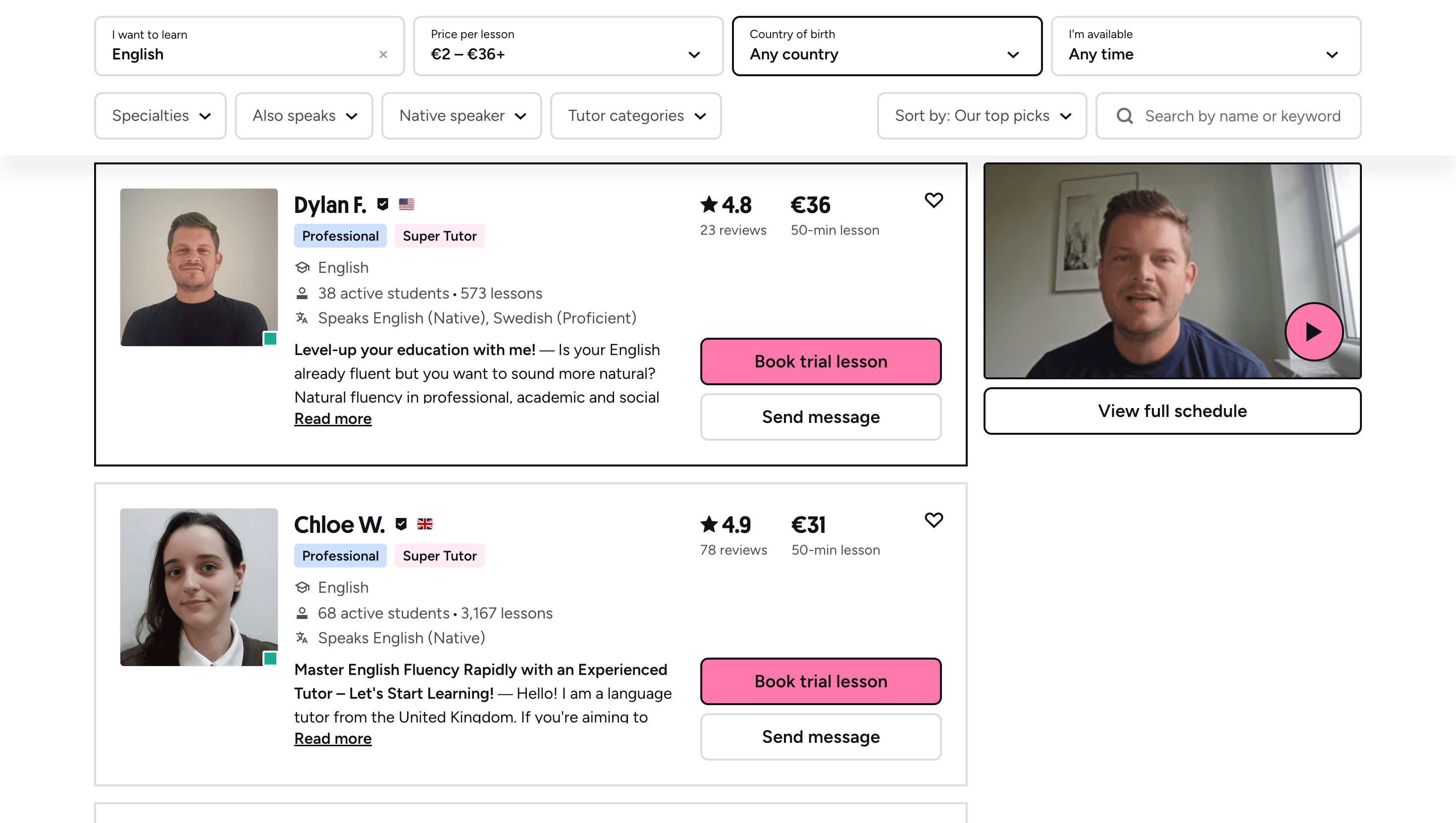
Many learners give up on language learning due to these high costs, missing out on valuable professional and personal opportunities.
That’s why we created Kylian: to make language learning accessible to everyone and help people master a foreign language without breaking the bank.
To get started, just tell Kylian which language you want to learn and what your native language is
Tired of teachers who don’t understand your specific struggles as a French speaker? Kylian’s advantage lies in its ability to teach any language using your native tongue as the foundation.
Unlike generic apps that offer the same content to everyone, Kylian explains concepts in your native language (French) and switches to the target language when necessary—perfectly adapting to your level and needs.
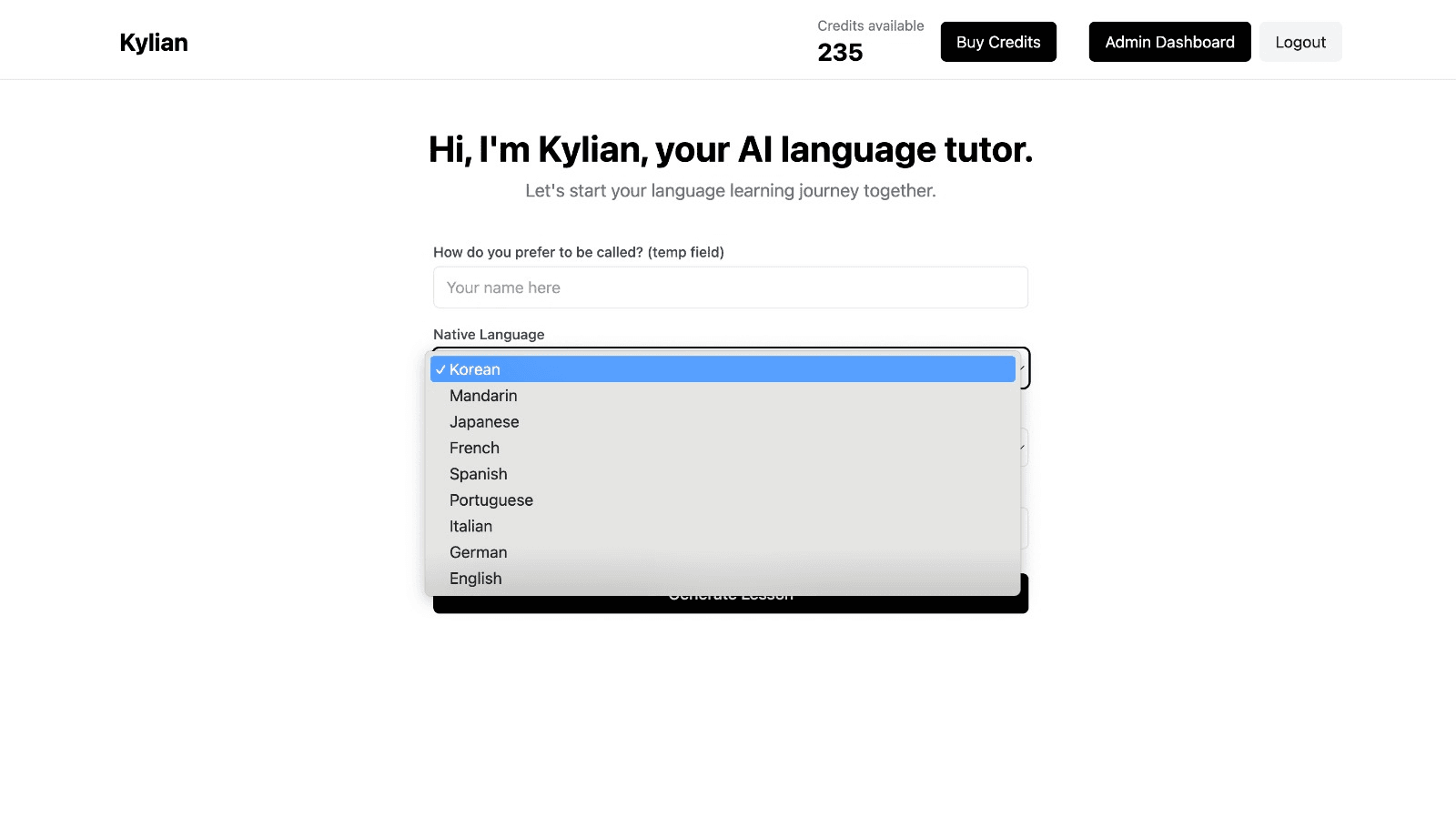
This personalization removes the frustration and confusion that are so common in traditional language learning.
Choose a specific topic you want to learn
Frustrated by language lessons that never cover exactly what you need? Kylian can teach you any aspect of a language—from pronunciation to advanced grammar—by focusing on your specific goals.
Avoid vague requests like “How can I improve my accent?” and be precise: “How do I pronounce the R like a native English speaker?” or “How do I conjugate the verb ‘to be’ in the present tense?”
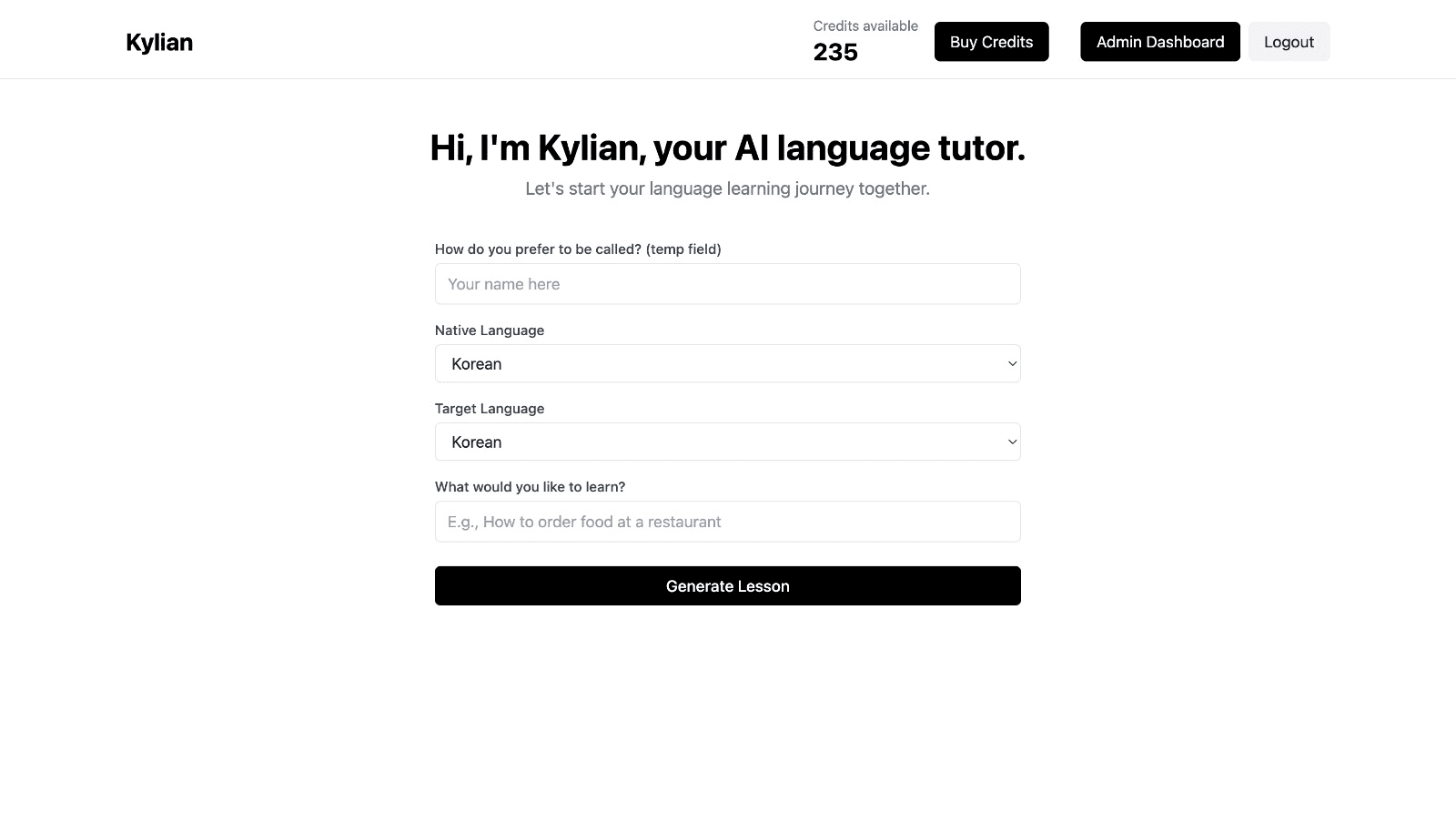
With Kylian, you’ll never again pay for irrelevant content or feel embarrassed asking “too basic” questions to a teacher. Your learning plan is entirely personalized.
Once you’ve chosen your topic, just hit the “Generate a Lesson” button, and within seconds, you’ll get a lesson designed exclusively for you.
Join the room to begin your lesson
The session feels like a one-on-one language class with a human tutor—but without the high price or time constraints.
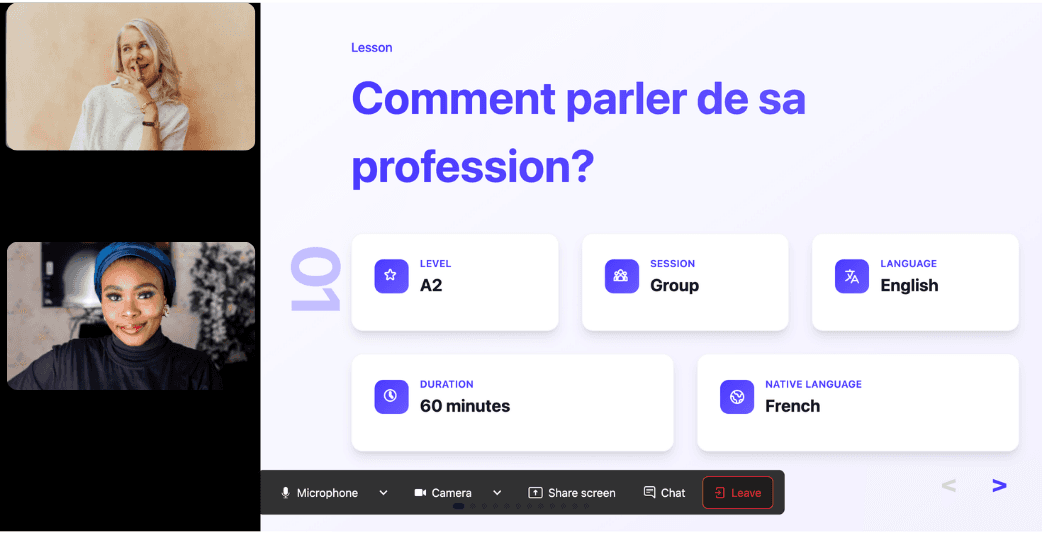
In a 25-minute lesson, Kylian teaches exactly what you need to know about your chosen topic: the nuances that textbooks never explain, key cultural differences between French and your target language, grammar rules, and much more.
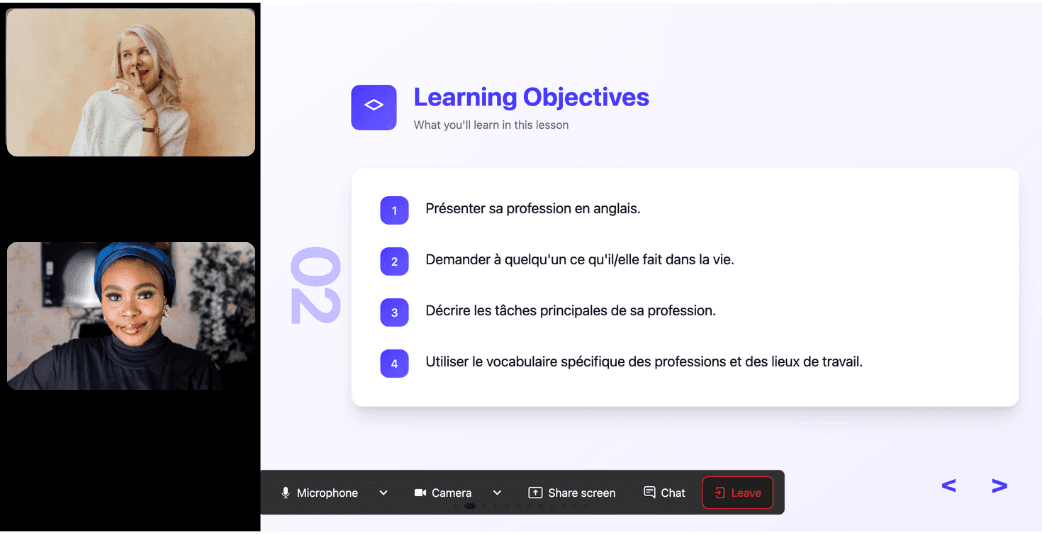
Ever felt frustrated trying to keep up with a native-speaking teacher, or embarrassed to ask for something to be repeated? With Kylian, that problem disappears. It switches intelligently between French and the target language depending on your level, helping you understand every concept at your own pace.
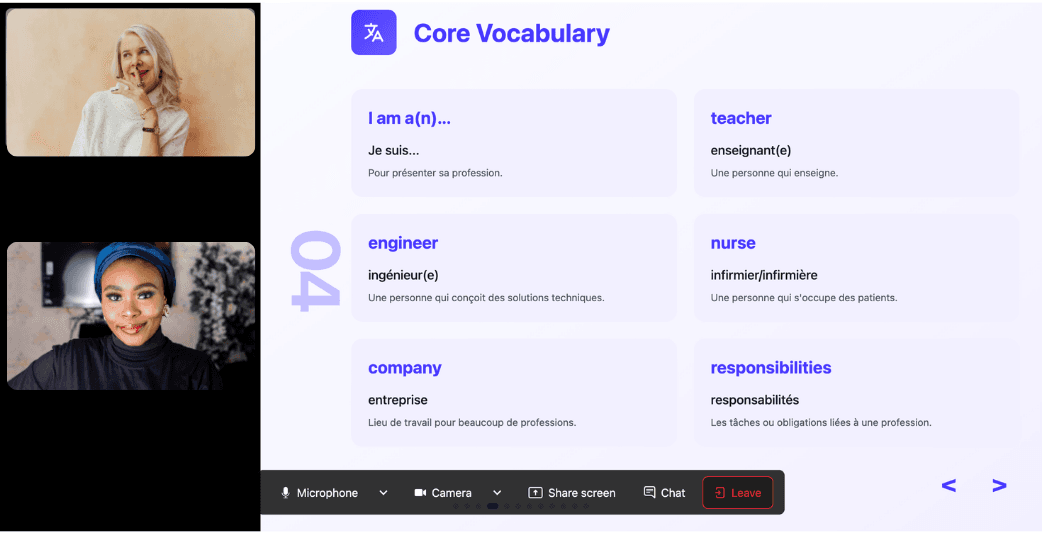
During the lesson, Kylian uses role-plays, real-life examples, and adapts to your learning style. Didn’t understand something? No problem—you can pause Kylian anytime to ask for clarification, without fear of being judged.
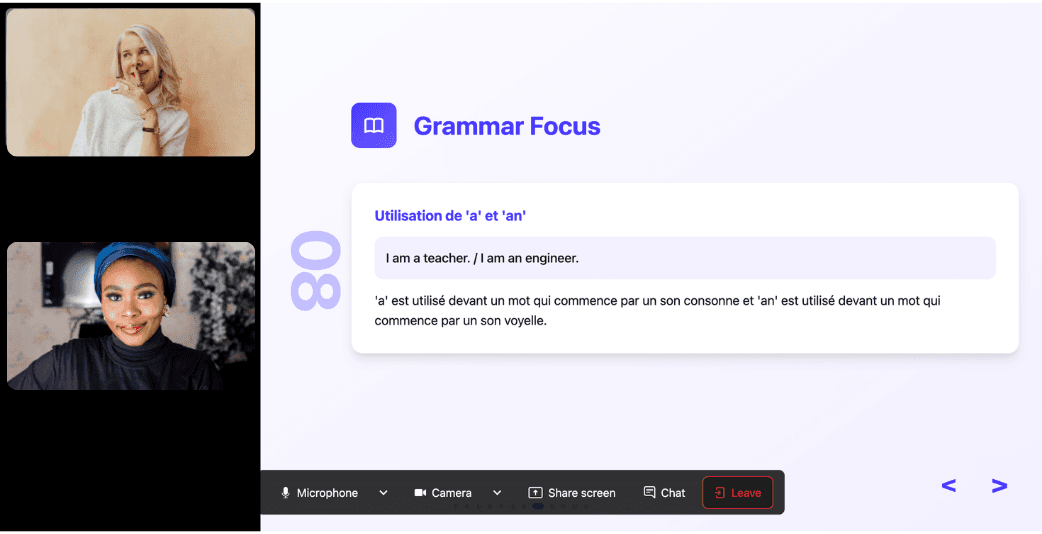
Ask all the questions you want, repeat sections if needed, and customize your learning experience in ways traditional teachers and generic apps simply can’t match.
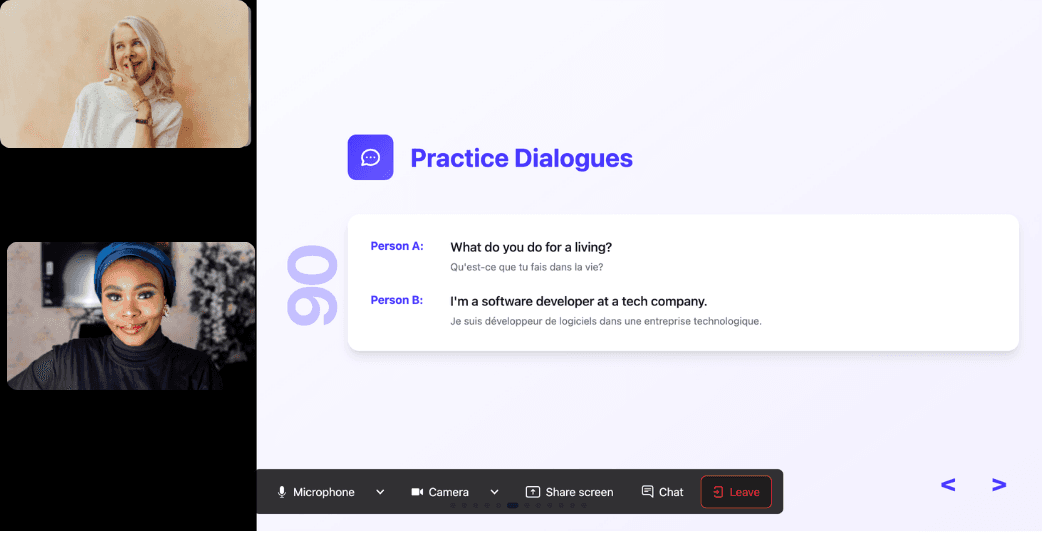
With 24/7 access at a fraction of the cost of private lessons, Kylian removes all the barriers that have kept you from mastering the language you’ve always wanted to learn.
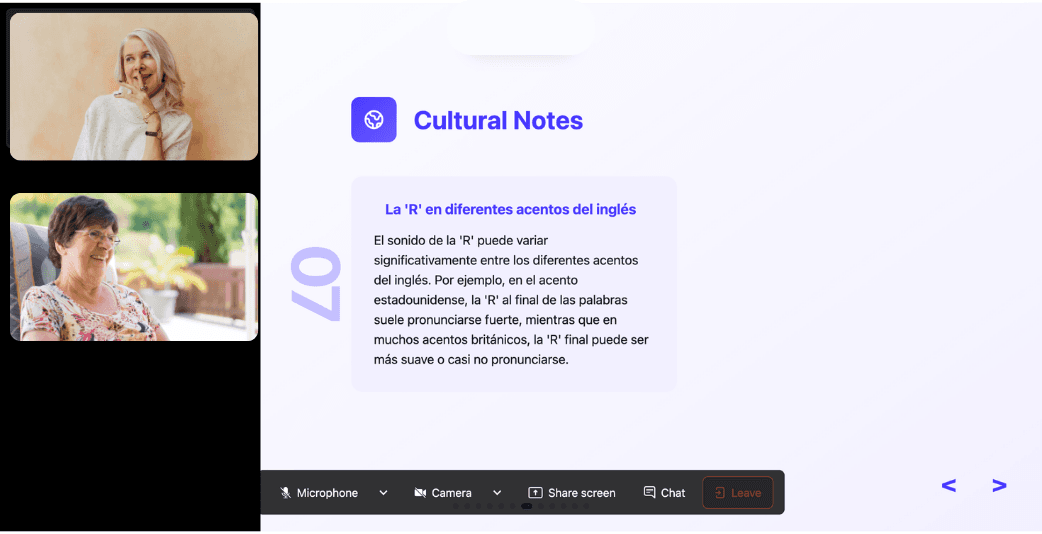
Similar Content You Might Want To Read

How to Learn Swedish: 10 Strategic Steps to Language Fluency
Swedish stands as a gateway to Scandinavian culture, opening doors to unprecedented opportunities for both personal and professional growth. As the most widely spoken North Germanic language, Swedish serves as a linguistic bridge connecting over 10 million speakers across Sweden and parts of Finland. What makes Swedish particularly appealing for English speakers is its Germanic roots—sharing vocabulary patterns, grammatical structures, and cultural references that create a surprisingly accessible learning path. Yet despite these advantages, mastering Swedish requires strategic approach and consistent practice. This comprehensive guide outlines ten evidence-based strategies that transform Swedish language acquisition from intimidating to achievable. Whether your motivation stems from career advancement, cultural immersion, or intellectual curiosity, these methods will establish a solid foundation for Swedish language proficiency.

Americans Reveal Most Impactful Words of Support
The language we choose in moments of struggle can either build bridges or create distance. Recent research analyzing nearly 1,000 Americans' experiences with supportive communication reveals a stark reality: while 42% of people share encouraging words daily, 60% find the support they receive feels hollow or insincere. This disconnect matters now more than ever. As workplace stress reaches unprecedented levels and personal relationships strain under modern pressures, understanding which words genuinely help versus those that inadvertently harm has become critical for leaders, colleagues, friends, and family members alike. The data exposes a fundamental gap between intention and impact. The phrases we instinctively reach for during difficult moments often rank among the most annoying to receive. Meanwhile, the words that truly resonate require more thoughtfulness and specificity than many realize.

Biff Slang in English: Definition and Cultural Context
Language continuously evolves, reflecting societal shifts and cultural phenomena. Among the numerous colloquialisms that have entered modern English vocabulary, "biff" stands out as a particularly versatile slang term with multiple interpretations and applications across different English-speaking communities.

What is a Consonant Letter? Complete English Guide
Language precision matters more than most people realize. Every time you speak or write, you're orchestrating a complex system of sounds and symbols that determines whether your communication succeeds or fails. At the foundation of this system lies a fundamental distinction that shapes everything from pronunciation to spelling patterns: the difference between consonant and vowel letters. Understanding consonant letters isn't just academic knowledge—it's practical intelligence that directly impacts your ability to decode unfamiliar words, improve pronunciation accuracy, and master spelling patterns that follow predictable rules rather than seeming arbitrary.

The Plural of Information in English
Understanding grammatical nuances fundamentally shapes how we communicate precision and intent in English. Among these subtleties, the question of how to properly pluralize "information" represents a fascinating linguistic challenge that reveals deeper patterns within English morphology. This examination matters because clarity in language directly impacts knowledge transfer—whether in academic writing, professional communication, or everyday conversation. The way we handle uncountable nouns like "information" demonstrates not just grammatical competence but conceptual understanding of how English categorizes abstract concepts. By addressing this specific grammatical point, we gain insight into the broader linguistic frameworks that govern how ideas are expressed across contexts and disciplines.

Teach Yourself Arabic: 10 Proven Self-Study Tips
Learning Arabic independently represents a meaningful challenge that yields substantial cultural and intellectual rewards. While the journey demands persistence, achieving fluency through self-study remains entirely possible with strategic approach and consistent effort. This guide provides comprehensive strategies for independent Arabic learners, highlighting essential techniques while identifying critical pitfalls that often derail progress. By implementing these research-backed methods, you'll establish sustainable learning patterns that convert initial enthusiasm into lasting linguistic competence.